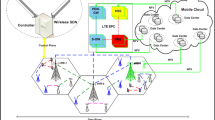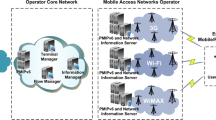Abstract
The 5th Generation wireless systems (5G) is expected to accommodate exceptional services beyond current cellular systems. To achieve this goal, however, ongoing studies are still developing new schemes to provide seamless connections to the ever increasing density of high-mobility User Equipments (UEs). That means that the network needs to track all UEs while moving throughout the coverage area for the purpose of data-packet delivery. The two Mobility Management (MM) procedures that are essential to localize a specific UE and deliver data packets to that UE are known as Tracking Area Update (TAU) and Paging, which are burdensome to the system because of very high-volume traffic. Therefore, MM will become a crucial problem for 5G requirements; how to support real-time applications and provide close-to-zero latency for life-critical systems? This paper addresses a variety of problems that should be faced and discusses various solution schemes in terms of implementation complexity, latency, and computation overhead for both the TAU and Paging. Because 5G systems will work in conjunction with current Long Term Evolution (LTE) systems and the latter is retuned to use as a base design for future 5G, our discussion starts from current LTE solutions towards 5G MM improvements. In this context, this paper emphasizes a new key design for 5G and explains the challenges that impact both the network performance and UE experience (e.g., power saving). Next, we critically discuss the applicability of current LTE solution schemes (in terms of TAU and Paging costs) and evaluate them for 5G use cases. To the best of our knowledge, this paper is the first study that emphasizes and gives a critique on using of different types of UE mobility models (based on the given studies), which are used to analyze the network performance that interacts with the UE movements. In this context, some 5G improvement schemes are discussed.







Similar content being viewed by others
Notes
Both LTE RAN and the EPC are referred to as the Evolved Packet System (EPS) [35]
Non-Access Stratum (NAS) is a set of protocols that are used to convey non-radio signaling between the UE and its serving MME for an LTE/E-UTRAN access
References
3GPP TR 23.799 V14.0.0: Study on architecture for next generation system (release 14) (2016). http://www.3gpp.org
3GPP TS 22.261 V16.1.0: Service requirements for the 5G system; Stage 1 (release 16) (2017). http://www.3gpp.org
3GPP TS 23.401 V14.4.0: General Packet Radio Service (GPRS) enhancements for Evolved Universal Terrestrial Radio Access Network (E-UTRAN) access (release 14) (2017). https://portal.3gpp.org
3GPP TS 23.501 V15.0.0: System architecture for the 5G system; Stage 2 (release 15) (2017). http://www.3gpp.org
3GPP TS 38.300 V15.0.0: NR; NR and NG-RAN overall description; Stage 2 (release 15) (2017). http://www.3gpp.org
Agyapong P, Iwamura M, Staehle D, Kiess W, Benjebbour A (2014) Design considerations for a 5G network architecture. IEEE Commun Mag 52(11):65–75. https://doi.org/10.1109/MCOM.2014.6957145
Akpakwu GA, Silva BJ, Hancke GP, Abu-Mahfouz AM (2018) A survey on 5G networks for the internet of things: Communication technologies and challenges. IEEE Access 6:3619–3647. https://doi.org/10.1109/ACCESS.2017.2779844
Alcatel-Lucent (2013) The impact of small cells on MME signaling: Methods to reduce and optimize MME core signalling caused by small cells. Tech Rep. http://www.tmcnet.com/tmc/whitepapers
Bagaa M, Taleb T, Ksentini A (2016) Efficient tracking area management framework for 5G networks. IEEE Trans Wirel Commun 15(6):4117–4131. https://doi.org/10.1109/TWC.2016.2535217
Bar-Noy A, Kessler I, Sidi M (1995) Mobile users: To update or not to update? Ph.D thesis. https://doi.org/10.1007/BF01202540
Bhattacharya A, Das SK (1999) Lezi-update: an information-theoretic approach to track mobile users in PCS networks. In: Proc. 5th annu. ACM/IEEE int. conf. mob. comput. netw. - mobicom ’99. ACM Press, New York, pp 1–12, DOI https://doi.org/10.1145/313451.313457
Chan J, Zhou S, Seneviratne A (1998) A QoS adaptive mobility prediction scheme for wireless networks. In: IEEE GLOBECOM 1998 (Cat. NO. 98CH36250), vol 3. IEEE, pp 1414–1419. https://doi.org/10.1109/GLOCOM.1998.776573
Chen L, Liu HL, Fan Z, Xie S, Goodman ED (2017) Modeling the tracking area planning problem using an evolutionary multi-objective algorithm. IEEE Comput Intell Mag 12(1):29–41. https://doi.org/10.1109/MCI.2016.2627669
Cheng KCK, Yap RHC (2008) Search space reduction for constraint optimization problems. In: Princ Pract Constraint Program. Springer, Berlin, pp 635–639. https://doi.org/10.1007/978-3-540-85958-1_56
Clayirci E, Akyildiz I (2002) User mobility pattern scheme for location update and paging in wireless systems. IEEE Trans Mob Comput 1(3):236–247. https://doi.org/10.1109/TMC.2002.1081758
Da Silva IL, Mildh G, Saily M, Hailu S (2016) A novel state model for 5G radio access networks. In: 2016 IEEE int. conf. commun. work. IEEE, pp 632–637. https://doi.org/10.1109/ICCW.2016.7503858
Deng T, Wang X, Fan P, Li K (2016) Modeling and performance analysis of a tracking-area-list-based location management scheme in LTE networks. IEEE Trans Veh Technol 65(8):6417–6431. https://doi.org/10.1109/TVT.2015.2473704
Ericsson Ericsson mobility report. Tech Rep. https://www.ericsson.com/en/mobility-report
Fan P, Zhao J, I CL (2016) 5G high mobility wireless communications: Challenges and solutions. China Commun 13(Supplement2):1–13. https://doi.org/10.1109/CC.2016.7833456
Fu HL, Lin P, Yue H, Huang GM, Lee CP (2014) Group mobility management for large-scale machine-to-machine mobile networking. IEEE Trans Veh Technol 63(3):1296–1305. https://doi.org/10.1109/TVT.2013.2284596
Ge X, Ye J, Yang Y, Li Q (2016) User mobility evaluation for 5G small cell networks based on individual mobility model. IEEE J Sel Areas Commun 34(3):528–541. https://doi.org/10.1109/JSAC.2016.2525439
Grigoreva E, Xu J, Kellerer W (2017) Reducing mobility management signaling for automotive users in LTE advanced. In: 2017 IEEE int. symp. local metrop. Area networks. IEEE, pp 1–6. https://doi.org/10.1109/LANMAN.2017.7972167
Hailu S, Saily M (2017) Hybrid paging and location tracking scheme for inactive 5G UEs. In: 2017 eur. conf. networks commun. IEEE, pp 1–6. https://doi.org/10.1109/EuCNC.2017.7980730
Jeon S, Figueiredo S, Aguiar RL, Choo H (2017) Distributed mobility management for the future mobile networks: a comprehensive analysis of key design options. IEEE Access 5:11423–11436. https://doi.org/10.1109/ACCESS.2017.2713240
Kim J, Kim D, Choi S (2017) 3GPP SA2 architecture and functions for 5G mobile communication system. ICT Express 3(1):1–8. https://doi.org/10.1016/J.ICTE.2017.03.007. https://www.sciencedirect.com
Kominami D, Iwai T, Shimonishi H, Murata M (2017) A control method for autonomous mobility management systems toward 5G mobile networks. In: 2017 IEEE int. conf. commun. work. (ICC work. IEEE, pp 498–503. https://doi.org/10.1109/ICCW.2017.7962707
Kyamakya K, Jobmann K (2005) Location management in cellular networks: Classification of the most important paradigms, realistic simulation framework, and relative performance analysis. IEEE Trans Veh Technol 54(2):687–708. https://doi.org/10.1109/TVT.2004.842459
Liou RH, Lin YB, Tsai SC (2013) An investigation on LTE mobility management. IEEE Trans Mob Comput 12(1):166–176. https://doi.org/10.1109/TMC.2011.255
Meng N, Zhang H, Lin B (2016) User-centric mobility management based on virtual cell in ultra-dense networks 2016 IEEE/CIC int. conf. commun. China. IEEE, pp 1–6. https://doi.org/10.1109/ICCChina.2016.7636899
Nawaz M (2013) Exploiting tracking area list concept in LTE networks. Ph.D thesis
Nguyen LD (2018) Resource allocation for energy efficiency in 5G wireless networks. EAI Endorsed Trans Ind Networks Intell Syst 5(14):154832. https://doi.org/10.4108/eai.27-6-2018.154832
Nguyen LD, Tuan HD, Duong TQ (2016) Energy-efficient signalling in QoS constrained heterogeneous networks. IEEE Access 4:7958–7966. https://doi.org/10.1109/ACCESS.2016.2626363
Nguyen NP, Duong TQ, Ngo HQ, Hadzi-Velkov Z, Shu L (2016) Secure 5G wireless communications: a joint relay selection and wireless power transfer approach. IEEE Access 4:3349–3359. https://doi.org/10.1109/ACCESS.2016.2582719
Nowoswiat D (2013) Managing LTE core network signaling traffic. Tech Rep, Nokia. https://insight.nokia.com/managing-lte-core-network-signaling-traffic
Olsson M, Sultana S, Rommer S, Frid L, Mulligan C (2009) SAE and the evolved packet core: Driving the mobile broadband revolution, 1st edn. Elsevier, New York
Osseiran A, Boccardi F, Braun V, Kusume K, Marsch P, Maternia M, Queseth O, Schellmann M, Schotten H, Taoka H, Tullberg H, Uusitalo MA, Timus B, Fallgren M (2014) Scenarios for 5G mobile and wireless communications: the vision of the METIS project. IEEE Commun Mag 52(5):26–35. https://doi.org/10.1109/MCOM.2014.6815890
Panwar N, Sharma S, Singh AK (2016) A survey on 5G: The next generation of mobile communication. Phys Commun 18:64–84. https://doi.org/10.1016/j.phycom.2015.10.006
Parija SR, Nath NP, Sahu P, Singh S (2015) Dynamic profile based paging in mobile communication. In: 2015 int. conf. microwave, opt. commun. eng.IEEE, pp 342–345. https://doi.org/10.1109/ICMOCE.2015.7489762
Razavi SM (2011) Tracking area planning in cellular networks - optimization and performance evaluation. Thesis, Linkoping University. http://liu.diva-portal.org/smash/get/diva2:402919/FULLTEXT01.pdf
Roy A, Misra A, Das SK (2007) Location update versus paging trade-off in cellular networks: an approach based on vector quantization. IEEE Trans Mob Comput 6(12):1426–1440. https://doi.org/10.1109/TMC.2007.1059
Roy A, Shin J, Saxena N (2012) Entropy-based location management in long-term evolution cellular systems. IET Commun 6(2):138. https://doi.org/10.1049/iet-com.2011.0289
Rumney M (2014) Taking 5G from vision to reality. https://blog.3g4g.co.uk/2014/07/taking-5g-from-vision-to-reality.html
Säily M (2016) Deliverable D6.1 draft asynchronous control functions and overall control plane design. METIS-II/D6.1. http://www.5g-ppp.eu/
Samaan N, Karmouch A (2005) A mobility prediction architecture based on contextual knowledge and spatial conceptual maps. IEEE Trans Mob Comput 4(6):537–551. https://doi.org/10.1109/TMC.2005.74
Scourias J (1997) Dynamic location management and activity-based mobility modelling for cellular networks. Thesis, University of Waterloo (Canada)
Song C, Qu Z, Blumm N, Barabȧsi AL (2010) Limits of predictability in human mobility. Science 327(5968):1018–21. https://doi.org/10.1126/science.1177170
Thompson T (2018) AT&T announces first 3 U.S. cities to receive 5G wireless. iDROPNEWS. https://www.idropnews.com/news/fast-tech/att-announces-first-3-u-s-cities-receive-5g-wireless/63923/
Vo NS, Duong TQ, Guizani M, Kortun A (2018) 5G optimized caching and downlink resource sharing for smart cities. IEEE Access 6:31457–31468. https://doi.org/10.1109/ACCESS.2018.2839669
Vo NS, Duong TQ, Tuan HD, Kortun A (2018) Optimal video streaming in dense 5G networks with D2D communications. IEEE Access 6:209–223. https://doi.org/10.1109/ACCESS.2017.2761978
Xiao Y, Chen H, Guizani M (2006) Performance evaluation of pipeline paging under paging delay constraint for wireless systems. IEEE Trans Mob Comput 5(1):64–76. https://doi.org/10.1109/TMC.2006.14
Yuen C, Elkashlan M, Qian Y, Duong TQ, Shu L, Schmidt F (2015) Energy harvesting communications: Part 1 [Guest Editorial]. IEEE Commun Mag 53(4):68–69. https://doi.org/10.1109/MCOM.2015.7081077
Acknowledgments
The first author was fully supported by Iraqi Ministry of Higher Education and Scientific Research through a scholarship grant no. 4650/11/16/2014.
Author information
Authors and Affiliations
Corresponding author
Rights and permissions
About this article
Cite this article
Alsaeedy, A.A.R., Chong, E.K.P. Tracking Area Update and Paging in 5G Networks: a Survey of Problems and Solutions. Mobile Netw Appl 24, 578–595 (2019). https://doi.org/10.1007/s11036-018-1160-6
Published:
Issue Date:
DOI: https://doi.org/10.1007/s11036-018-1160-6




